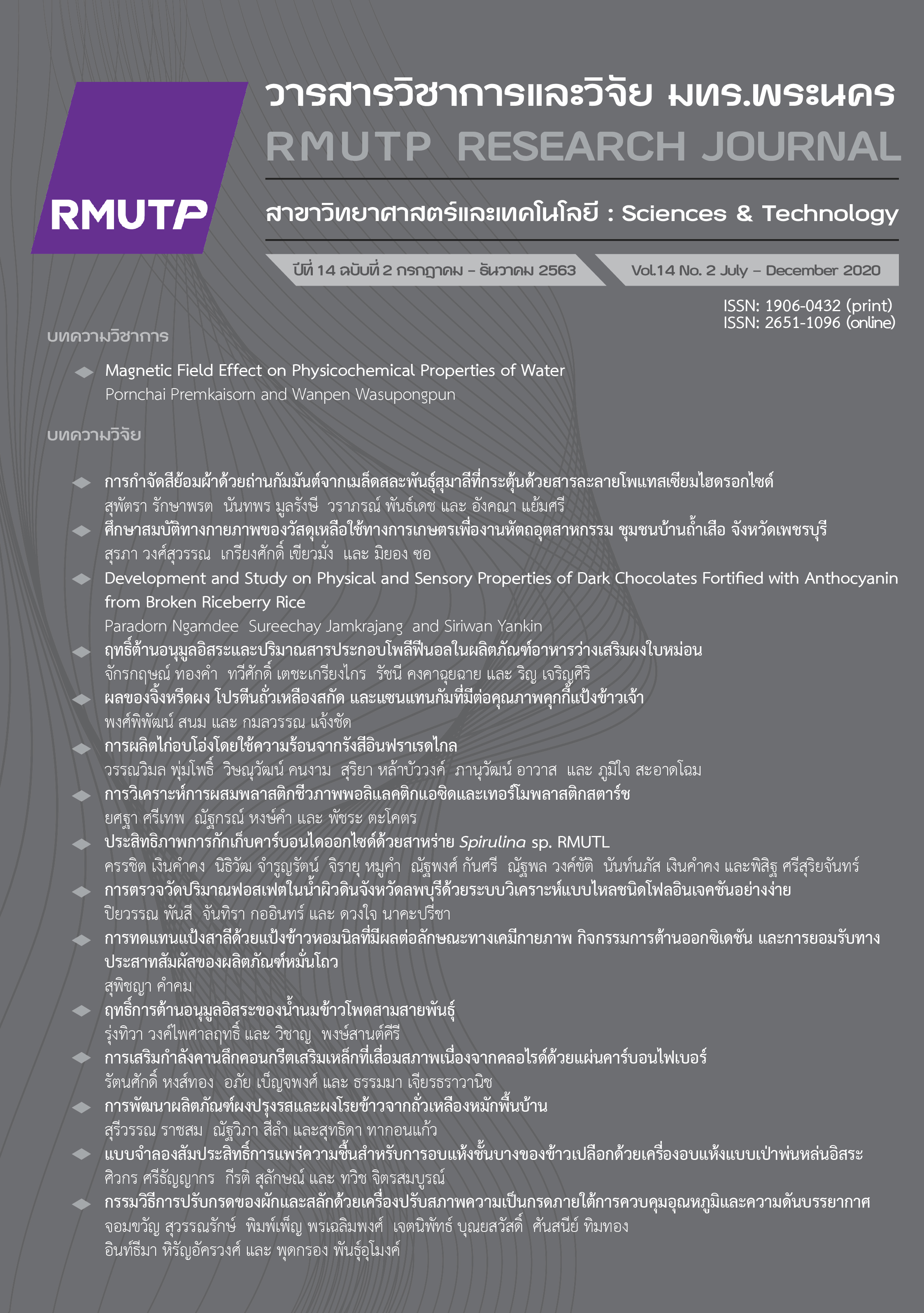Development of Seasoning Powder and Furikake-rice Seasoning from Fermented Soy Bean
Main Article Content
Abstract
This research aims to develop the new product from a northern local fermented soy bean which were seasoning powder and furikake-rice seasoning and analyze to observe the nutritional, chemical component and antioxidant of the products. The fermented soy bean was dried using hot air oven to achieve a required moisture content prior to apply to the new product. The best ratio of the dried fermented soybean powder was of 35%. The sensory test was used to evaluate the customer acceptance in these developed products. The results showed that the panelist moderately like the products with the overall acceptable score of 7.85±0.36 for the seasoning powder and 7.46±0.67 and 7.44±1.01 for furikake-rice seasoning in sesame-seaweed and garlic flavors, respectively. The analysis of the nutritional values (protein, fat and antioxidant) of the product were analyzed. The result showed that the seasoning powder has the highest values of nutritional values which were 43.80%, 19.24% and 3.72 µmol TE/g, for protein, fat and antioxidant respectively. The furikake-rice seasoning sesame-seaweed have the values of protein, fat and antioxidant of 29.90%, 9.72% and 1.79 µmol TE/g respectively. The garlic flavor has the values of protein, fat and antioxidant of 31.70%, 20.51%, 1.96 µmol TE/g, respectively. The developed product would be continuously produced in a commercial product for the local community since the fermented soybean products have high amount of nutrition especially the protein content.
Article Details
References
Nutrition division, Department of health, Ministry of public health, Nutritive values of Thai foods, 3rd ed. Bangkok: The War Veterans Organization of Thailand, 2001, pp. 15-20.
J. Japakaset, C. Wongkhalaung and V. Leelawatcharamas, “Utilization of soybean residue to produce monacolin K-cholesterol lowering agent,” Songklanakarin Journal of Science and Technology, vol. 31, no. 1, pp. 35-39, Jan.-Feb. 2009.
S. Vongpiphan, “Development of functional food from soybean yoghurt for menopause,”M.S. thesis, Dept. Food Tech., Silpakorn Univ., Bangkok, Thailand, 2007.
N. Rattanapanon, Effect of processing on food and nutrition in food, Food science and technology, Chiangmai: Faculty of agro industry, Chiangmai University, 2000.
T. Runnum. (2014, October 15). ThuaNao: Lanna local wisdom food. [Online]. Available: https://www.stou.ac.th
L. KeShun, “Chemistry and Nutritional Value of Soybean Components,” Soybean Chemistry Technology and Utilization, L. KeShun, New York: Chapman and Hall, 1997, pp. 25-113.
E. Chukeatirote, S. In-khian, K. Dajantaa and A. Apichartsrangkoon, “Thua Nao-An Indigenous Fermented Soybean of Thailand,” SWU Sci. J, vol. 27, no. 1, pp. 197-213, Jun. 2011.
S. Rajchasom, J. Vuthijamnonk, N. Seelum and S. Takornkwea, “The study of drying condition for local dried fermented soybean (Thua Nao),” International Journal of Food Engineering, vol. 5, no. 2, pp. 116-120, Jun. 2019.
P. Kaewsritho, N. On-Nom, U. Suttisansanee, T. Winuprasith, R. Chamchan, N. Sriden, A. Aursalung and Y. Sahasakul, “Development of healthy Tom Yum flavoured rice seasoning (Furikake) from vegetable powder,” Agricultural Sci. J., vol. 49, no. 2, pp. 165-168, Jun. 2018.
W. Brand-Williams, M. E. Cuvelier, and C. Berset, “Use of a free radical method to evaluate antioxidant activity,” LWT - Food Sci. Technol., vol. 28, no. 1, pp. 25–30, Jan. 1995
P. Pornchalermphong and N. Rattanapanon. (2010, May 10). Glutamic acid. [Online]. Available: http://www.foodnetworksolution
.com
Thai industrial standards institute (2005, September 10). Community product standard Thua-Nao Powder [Online]. Available: http://app.tisi.go.th
R. Phongsawadmanich and P. Vuttijumnon, Food product shelf-life evaluation and extension, Bangkok: O.S. printing house, 2017.
A. Halee and B. Rattanapun, “Study of antioxidant efficacies of 15 Local herbs,” KMUTT Research and Development Journal, vol. 40, no. 2, pp. 283-293, Dec. 2017.
World Health Organization (WHO) Food and Agriculture Organization (FAO). Vitamin and Mineral Requirements in Human Nutrition: Report of a Joint FAO/WHO Expert Consultation, Bangkok, Thailand, 21–30 September 1998. WHO, FAO; Geneva, Switzerland: 2004. p. 341.


